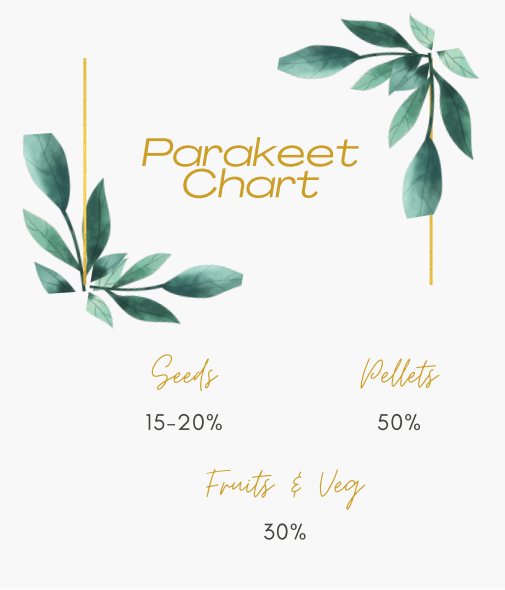Parakeets are small, intelligent, and colorful birds. They are the most popular pet birds in the US and elsewhere. According to the AVMA (American Veterinary Medical Association), the average lifespan of parakeets is 6 – 8 years, but they can live up to 18 – 20 years if handled with care. With the right choice and diligent care—taking care of their environment, routine, and diet—you can enjoy the relationship with your little companions for a long time.
So, how to care for a parakeet? Care is an essential element for parakeets to ensure their mental and physical health and a longer lifespan. In this article, you will find advice regarding how to care for your parakeet in the best possible way.
How to Care For a Parakeet
A happy parakeet is a healthy parakeet. Care for parakeets is not limited merely to their diet and cage. Instead, it starts the day when you get a bird and ranges from food to its mental health and beyond.
Parakeets are very social birds, requiring attention and affection from the owner. So, the question is, are parakeets good pets for everyone? No, they are not a good choice for those who have hectic schedules, with not enough time to give attention and devotion to the bird.
If a parakeet remains lonely for a long time, it gets depressing, which leads to mental and health issues. These parakeets adopt different habits to overcome their depression, like clipping their beaks, biting, and feather pulling.
Therefore, for owners, it is important to understand the ins and outs of petting a parakeet.
Picking a Parakeet
There are more than 120 parakeets’ breeds. Every breed is different from the other when it comes to its appearance, needs, and habits. There is even a clear distinction between male and female parakeets in some breeds.
Parakeets are famous for their colors and size. They are talking birds and love singing and mimicking people or animals around them.
It should be kept in mind that if you have a parakeet, it might get loud sometimes. But there are many breeds of parakeets that prefer to use the non-verbal mode of communication instead of excessively chirping and singing.
Here are few things that you should be careful about while picking a parakeet.
1. Choosing right breed
These Australian native birds have more than 120 breeds, but only 30 are considered fit to be kept as pets.
Of all the types of parakeets, the most common parakeet breed as a pet is Budgerigar. They are low-maintenance and cost-effective birds.
If you are looking for other types of parakeets, go for the breed that suits your budget and lifestyle. Note that the rarer the bird, the more the cost.
It is preferred to get a pet from a reputable pet store. They take care of them properly, and in some cases, you might not even need a vet to examine your bird for any infections.
After selecting your breed of interest, get the young parakeets instead of adult or old ones. Young parakeets are easy to bond with owners and can be easily trained, unlike the older ones.
2. Selecting a Right Bird
When you know the breed you want, go for a parakeet that is lively and bright-eyed.
Look for the place where they are kept in the store; it will give you an idea regarding the environment and condition in which the bird is kept.
Avoid parakeets with missing feathers or dirty wings and tails. The best way to predict a bird’s condition is by looking at its feet. If they are infected or injured, consider that a red flag.
3. Get Them in Pairs
As mentioned above, parakeets are social birds, fond of interacting with other birds and humans. Since it is practically very difficult for owners to be around all day, getting a pair of parakeets instead of one is recommended.
Get both parakeets at the same time, as it will help them to bond together in their new home. Once a parakeet starts living alone, it is very difficult for it to get along with other birds or share its space with newcomers.
If a person wants to get more than one pair of parakeets, it is not a problem. They will get along easily, as in the wild, parakeets live in flocks of 5 – 100 birds. While you can keep as many parakeets as you want, it is recommended to get 2 or 3 parakeets, as they are easy to handle and care properly for.
Parakeet Care Sheet

Parakeets care sheet includes all the basic and necessary care tips required for a healthy and happy parakeet.
1. Diet
Caring for parakeets is chiefly based on the type of feed you provide them. Parakeets are fragile birds with sensitive stomachs. A little disturbance can cost them their life—thus, owners are advised to be diligently careful of what their birds swallow.
As the image below shows, parakeets’ food essentially includes seeds, pellets, and fruits. For young parakeets, only seed-based food is recommended. One, it meets their nutritional requirements, and two, it is easy to digest.
But as the parakeets grow, their needs change. Relying only on a seed-based diet would cause obesity, which leads to serious health issues, like hemorrhage and blood clotting. Therefore, a seed-based diet should be only 15-20% of the parakeet’s daily meal.
To meet the other nutritional requirements of parakeets, pellet-based food is recommended. It is enriched with crude fiber and protein to ensure better that parakeets thrive. Pellet-based food should be 50% of an adult parakeet meal.
Lastly, parakeets love fruits and vegetables. According to the parakeet food chart, fruit and vegetable portion constitute 30% of the parakeet diet.

What Parakeets Eat?
As discussed above, pellets, seeds, and fruits and vegetables combined make a healthy meal for a parakeet.
Few people think that if they give their parakeets excessive fruits, it will help them nourish better. But this is not true; it will cause more negatives than positives.
Fruits have higher sugar content, excess of which can cause obesity. If given in excess for an extended time, it can lead to diabetes.
Fruits with higher water content are also considered health hazards for parakeets. Their excessive intake can cause diarrhea.
Excess of everything is bad; while feeding your bird, try to keep everything in moderation.
What Food to Avoid Giving Parakeets?
Avoid food that is at high risk of pesticides and fertilizers and is difficult to wash, like strawberries, tomatoes, celery, and cherries.
Parakeets can have these fruits only if they are properly soaked and cleaned in saline solution (3part water + 1part salt) or baking-soda solution (3 part water + 1part Baking soda).
Some fruits seeds are rich in toxins that can risk your bird’s life, like apple seeds. Remove seeds before giving apples to your bird.
Similarly, you can feed your parakeets blueberry seeds. They are completely healthy for your bird. They are rich in antioxidants, which improve the blood regulation and heartbeat of parakeets.
What to feed your parakeet if you run out of parakeet food? The first option that may cross your mind is bread. But it is not a good choice for your parakeet, as it contains preservatives and other fermenting bacteria, which can upset the bird digestive system.
Other foods that are considered toxic for your little birdie are:
- Mushrooms
- Avocados
- Uncooked beans
- Chocolates
- Beverages (Coffee or Carbonated drinks)
2. Water
Like humans, parakeets also need a continuous supply of fresh water. That is why it is necessary to change your bird’s water at least once a day.
Waterer will require cleaning only once a day, but you might need to clean it thrice if you give them water in a dish or a pot.
2. Cage
The housing of parakeets is also included in the primary care of birds. Parakeet spends most of the time in their cages. It should be complete with all the accessories that help them overcome boredom when you are not around.
Get a big cage as much as you can, or at least a cage with a size of 18 x 14 x 22 inches. The bigger the cage, the more comfortable the bird.
The cage should be built up of safe materials. It is because birds have a curious nature, often wandering around the cage. If it contains sharp edges, the bird might get hurt or cause injury to itself.
Parakeets enjoy quiet places. Place their cage in a quiet room or room with little to no disturbance. Avoid placing it near windows or in front of doors. Too much light can affect the birds’ pupils, and in some cases, induce molting.
These are few things that you can do to make a perfect home for your little bird.

Cage Accessories
Apart from the essentials, there are a variety of toys that you can select for entertaining your bird. These include:
- Perches, on which your parakeet stands. At least three.
- Swing
- At least 1 waterer
- Food bowls (metal)
- Bedding
- Cuttlebone
- Shredding toys
- Climbing toys
- Bell toys
All these will help your parakeet in staying happy. And a happy parakeet is a healthy parakeet, as we said in the beginning.
Health Care
Healthcare is also a necessary element in parakeet care. Apart from catering to their mental health, they need regular vet checkups—standard healthcare helps your budgies live long.
As explained above, parakeets’ feet are prone to diseases; if a bird is ill, it will be visible from its feet.
Keep a regular check on your bird. These are few indications of a healthy bird, including:
- Intact and firm beak
- Waxy cere
- Even flight
- Firm drop
- Active in morning
If you observe any difference in the above, that might be an indicator of poor health. Immediately take your bird to the vet.
How to care for a parakeet? Hope this article helped you. Remember that proper care can make a parakeet live up to 25 years. Pet parakeets are dependent on their owner for all their needs, whether it is healthcare or diet. Diet is considered the main element for your little bird care. It plays an important role in your birds’ health, along with suitable housing.
